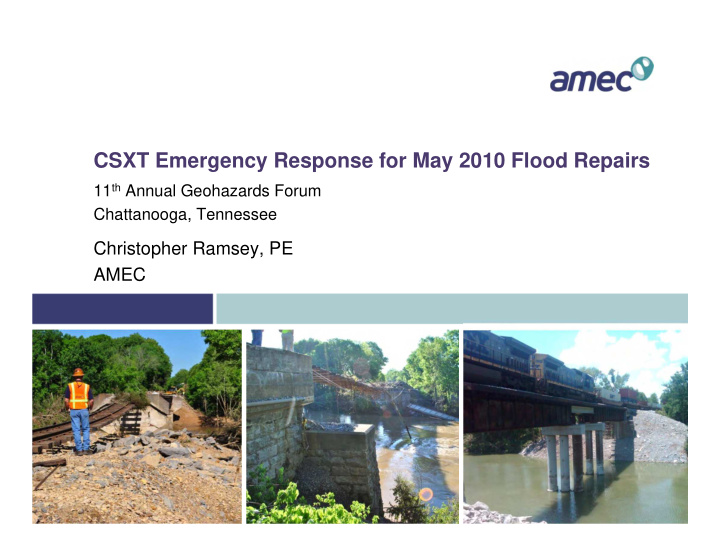



CSXT Emergency Response for May 2010 Flood Repairs 11 th Annual Geohazards Forum Chattanooga, Tennessee Christopher Ramsey, PE AMEC
Project Overview Record rainfalls affecting greater Nashville. Some areas recorded greater than 19 inches of rain over May 1 & 2, 2010 Tailwaters of the Cumberland River flood due to the unprecedented precipitation event CSX Transportation lines in the Kingston Springs area west of Nashville along the Harpeth River, and beyond, are damaged and in need of repair CSXT selects a team of engineers and contractors, which included AMEC, to inspect, permit, re-design & repair over 200 miles of track which extended from Nashville to Memphis 2
Project Overview, cont’d Over 37,000 feet of railroad track required repair of some kind Several culverts were washed out which then had to be restored, cleaned or upgraded Two bridges, which supported track over the Harpeth River were damaged. Both bridges were 3 span structures. One was completely washed out, including loss of 2 center piers. The other had one span washed away. Bridges affected were located at mileposts (MP) 17.4 & 23.5 3
Project Overview, cont’d The project team collaborated to determine the best solution that would restore rail traffic in a rapid and safe manner The team sought out available equipment and materials prior to commencing design Items such as available pre-fabricated steel spans, drilled shaft steel casing and appropriate foundation equipment were evaluated for suitability 4
Milepost 17.4 assesment MP17.4 constructed in 1878 and rebuilt in 1930, 2 piers and 2 abutments consisting of stone masonry bearing on bedrock All three spans washed down stream, both piers were forced over due to flood waters West embankment and roadbed damaged 5
Milepost 17.4 assessment, cont’d 6
Milepost 17.4 assessment, cont’d 7
Milepost 17.4 assessment, cont’d 8
Milepost 17.4 assessment, cont’d 9
Milepost 23.5 assessment MP 23.5 is a three span bridge totaling approximately 296 feet, with eastern most span washed out Both approach embankments damaged with severe roadbed damage mainly to the east Constructed in 1922, consisting of stone masonry piers and abutments bearing on bedrock 10
Milepost 23.5 assessment, cont’d 11
Milepost 23.5 assessment, cont’d 12
Milepost 23.5 assessment, cont’d 13
Milepost 23.5 assessment, cont’d 14
Site Investigation Preliminary plan is to install two new piers at MP17.4 and one new pier at MP23.5 Drill one boring, including rock core, at each bridge site Boring at MP17.4 site drilled just downstream at approximately center of total span. Boring at MP23.5 site drilled on location of proposed replacement pier 15
The Repair Plan, MP17.4 Utilize steel spans available for immediate delivery and tailor design based on that availability Permanently cased, rock bearing, steel reinforced drilled shafts for new pier supports Drilled shafts also sized based on availability of material, specifically casing sizes 16
The Repair Plan, MP17.4 (as conceived) Single element was used to extend from base of pier cap into bedrock Single piece of steel casing placed into drilled rock socket Reinforcing steel cage placed and the element was concreted Annulus between casing and bedrock socket was grouted 17
The Repair Plan, MP17.4 (as constructed) Single element was used to extend from base of pier cap into bedrock Temporary casing, left in place, used through shot rock fill bench to bedrock Single piece of steel casing placed into drilled rock socket and welded to temporary casing Annulus between casing and bedrock socket was grouted Reinforcing steel cage placed and the element was concreted 18
19 Milepost 17.4 Repair
20 Milepost 17.4 Repair
21 Milepost 17.4 Repair, cont’d
22 Milepost 17.4 Repair cont’d
23 Milepost 17.4 Repair cont’d
The Repair Plan, MP23.5 Same approach taken, to utilize steel spans available for immediate delivery and tailor design based on that availability Span too large for any available material, so an intermediate pier was installed Permanently cased, rock bearing, steel reinforced drilled shafts for new pier support Relatively lighter load, so drilled shaft casing sizes were readily available 24
25 Milepost 23.5 Repair
26 Milepost 23.5 Repair cont’d
Project Summary Rail traffic was restored in just 21 calendar days after initial inspection AMEC coordinated with concerned agencies such as USACE, TDEC and US Coast Guard to discuss environmental permitting requirements HDR, Inc. performed superstructure design while AMEC design the foundations AMEC aided design and inspection of localized slope and culvert failures along the Bruceton and Henderson Subdivisions The project team worked together to provide a comprehensive solution after a crippling catastrophe 27
Project Summary, cont’d ACEC of Tennessee Engineering Excellence Grand Award winner, Special Project Category Quotes from Award Judges: “The complexities of a disaster, coupled with pressure from the client for a high quality and rapid repair, requires a level of rigor that surpasses the “normal” engineering project. In this case, superb orchestration of construction, design and permitting, which were all running parallel paths, resulted in the 21 day return to service of the CSX mainline rail.” “Special consideration for disaster response, engineering design decisions, mobilization & construction/repair all contributed to make this project unique and worthy of the Engineering Excellence Award.” 28
29 Bridge 17.4, Finished
30 Bridge 17.4, Finished
31 Bridge 23.5, Finished
32 Bridge 23.5, Finished
33 Bridge 23.5, Finished
34 Questions?
Recommend
More recommend